
Ornamental Grasses are a welcome addition to any garden - in almost any situation. The fact that 'grass' is so commonplace - lawns, weeds, cereal crops, and now even as bio-fuel, sometimes puts gardeners off using this wide range of plants for the ornamental garden.
Rest assured that the ornamental grasses that are mentioned in this section, will be a delight and in no way can they be described as weeds.
There are several plant groups that are similar to grasses, such as Acorus and Cyperus. These are not true grasses (Members of the Gramineae family) but sedges and the like. We will not include those here. Bamboos are members of the grass family, but we will devote a separate section for those also. In this section, we refer to those grasses that are commonly called ornamental grasses.
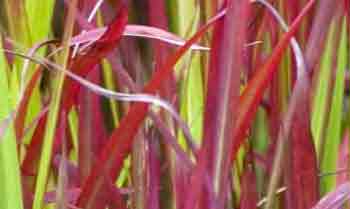
Red Baron
They can be evergreen or deciduous, hardy or tender, perennial or annual, mound forming or erect, sun loving or shade loving. The one thing that most ornamental grasses have in common, is that they are more or less trouble free from pests and diseases, are easy to grow, and have a long period of interest in the garden.
Grasses are available for any situation in the garden....They don't all grow as big as Pampas Grass!
Some ornamental grasses are evergreen - others are deciduous. Just a few are annuals - having to be sown each year (though they normally do this for themselves once established - but most are perennials, As such the re-grow each year and grace the garden through late spring and summer, and then into their own during the Autumn and Winter.
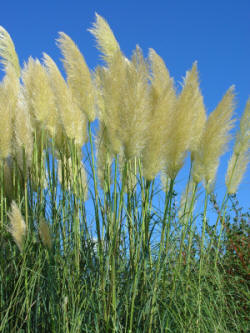
Pampas Grass
Ornamental garden grasses are important additions to all gardens - large or small. Most ornamental grasses are NOT like Pampas Grass! Some are low growing - to the extent of ground-hugging and there are also good weeping forms most suited for patio tubs.
Our A - Z list of garden grasses includes the most popular types, with choices of evergreen or deciduous, short or tall, compact or floppy. In your choice of ornamental grass, be sure to get the correct name. For instance there are many Miscanthus sinensis types - all having different characteristics. Hopefully our list and images will help you track down the ornamental grass that you require.
The latter part of the year is my favourite for the splendour of grasses turning colour, as the Autumn progresses and the flower heads turn to no-less attractive seed heads. The only thing that can beat them for Autumn interest, is the vibrant colours of the Japanese Maples. But wait! The Japanese Maples - and other Autumn foliage plants lose their leaves - and interest in a matter of a few weeks.
The colour and interest of Miscanthus grasses in the Autumn can last for months! The seedheads at this time, also being havens for all manner of wildlife - especially birds in search of a late feed!
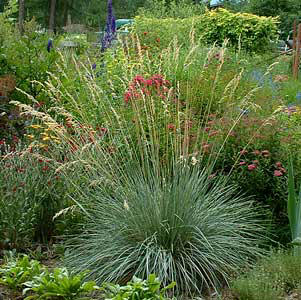
Blue Oat Grass
Ornamental garden grasses are wide ranging with many cultivars. It is always best to try and obtain with the proper botanical cultivar name.
However, even with the proper name, it is not always possible to get what you are really after because of the wide variations resulting from growing grasses from see (The easy way). A good supplier will have stock that is true from selected plants.
Grasses for the garden come in all shapes and sizes. Together with that, there are many types of ornamental grass structural forms to choose from, ranging from the majestic Miscanthus to the mound forming Carex types and the low growing - almost ground hugging - Ophiopogon and Hakonechloa. If it is sheer height that you want, then of course there are the various types of Cortaderia (Pampas), and the lesser known skyscraper grass - Arundo.
The pictures below will give you a starter idea of the types of ornamental grasses that are available for general garden use.
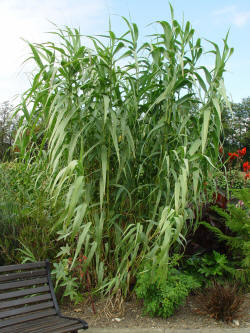
Arundo Donax
For sheer size and quickness of growth, there are few - if any - ornamental grasses that can compete with Arundo donax.
The one in the image below, has put on that much growth - around 2 metres - in three or four months. It dies down each Autumn - only to re-emerge again in the Spring and soon gets to is ultimate height of around 3 metres. It is often mistaken for a bamboo, and of course the bamboos are of the same family as the grasses.
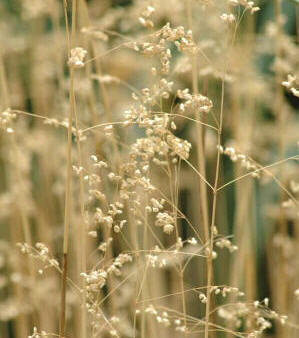
Briza
The best time to plant a shrub used to be autumn – with a few exceptions. Many writers will say anytime is ok for a container-grown shrub, and garden centres will agree, because it gives them ‘all year trade’. But the subject of when to plant a shrub is dependent upon several features.
Briza minor and Briza maxima are both annuals - so have to be sown every year - whilst Briza media - image below - is a perennial that renews its growth each spring, after dying down to ground level for the winter.
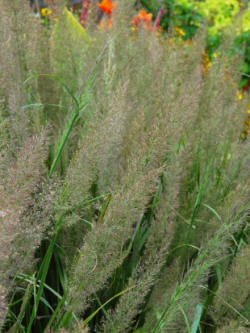
Calamagrostis brachytricha
The Calamagrostis group of ornamental grasses have some useful members - most of which are long flowering, and persist well into the winter with their attractive seedheads.
They are well suited to perennial herbaceous borders where they make elegant additions to the oft sprawling plants in the herbaceous border.
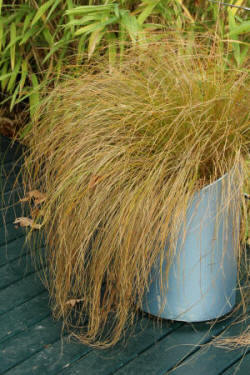
Carex
Carex is a wide range of garden grasses, (actually sedges and not proper grasses) ranging in shape from ground hugging, through trailing and then upright. So it will be seen that it is very important to know exactly which Carex you want!
The images below show three different types of colourful foliage growth that are to be found in the Carex Ornamental Grasses. The Carex group of grasses is also blessed with a good colour range to the foliage. Green, Golden variegated, Silver variegated and bronze.

Cortaderia selloana
Pampas Grass - Cortaderia selloana - is one of the most spectacular - yet often hated, of the ornamental grasses. We get many emails every year asking how to get rid of it!
If Pampas grass is planted in the right place, it will give many years of stunning plumes of flower - for which it is rightly noted.
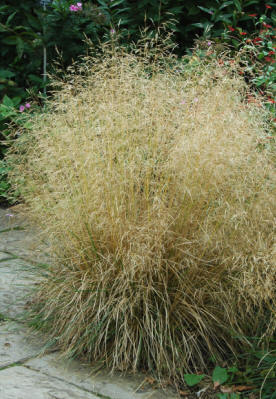
Deschampsia
Deschampsia cespitosa Goldtau - Golden Dew - is a perennial ornamental grass that forms dense tussock of foliage topped with flower spikes that are gold in colour.
They are happy in most garden soils, but prefer the soil to be non-alkaline - acid or neutral. Deschampsia are hardy grasses - and this particular one is normally evergreen - in milder winters, or herbaceous, in that it dies down to re-emerge in the spring.
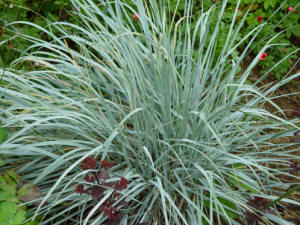
Elymus hispidus
Do not be put off by the common name of the Elymus group of ornamental grasses. The cultivated forms that are available for the garden are nor 'wild' - even though the dreaded couch or twitch grass is a member of the same family.
Elymus hispidus is stunning blue grass, forming a mound of metallic blue foliage. It is normally evergreen in all but severe winters, but perennial, so will re-emerge if it dies down for the winter.

Blue Fescue Grass
Festuca glauca is a dwarfish type of ornamental grass with blue foliage and green flowers, that turn to light straw brown in the Autumn.
It shows well when planted as clumps or drifts, but here in the image you can see how effective it is against a pebble background. The dark of the background also helps to highlight the seedheads - especially with the low sun light of the autumn and winter months.
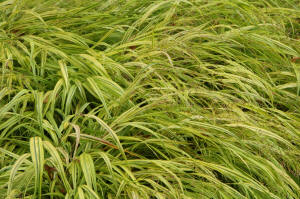
Hakonechloa
The Hakonechloa is one of the best tuft or mound forming grasses, with bright gold foliage in the summer, followed by straw coloured foliage in the autumn.
It is a very versatile ornamental grass - being at home in rock garden, at front of shrub or perennial border, on in containers - window boxes included.
Hakonechloa is low growing, and forms a dense, colourful groundcover carpet if planted in groups.

Helictotrichon sempervirens
Helictotrichon sempervirens is an evergreen grass, with a dense tussock of green grey foliage, from which the with long stems of flowers emerge in early to mid summer. The flowers and resultant seedheads stand erect but with a somewhat arching habit at the tips..
Helictotrichon is well suited to growing in dry areas and is best displayed as an 'un-crowded- specimen grass, so that the foliage head and flower spikes can be appreciated best. Full sun is the best option, but this grass is also happy in dappled shade.
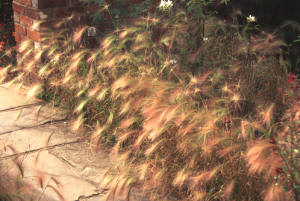
Hordeum jubatum
Hordeum jubatum is sometimes perennial, sometimes annual! It matters not, for they freely seed themselves, so to all intents and purposes can be regarded as perennials.
The foliage is of little consequence - other than the good autumn colour. It is the flowers which are mainly of interest - especially to flower arrangers and those who like to dabble in 'dried' flowers!
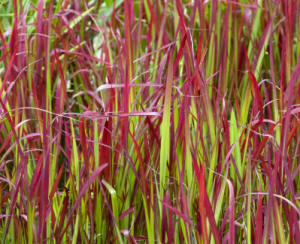
Red Baron
The striking red colour of the Imperata cylindrica Rubra Red Baron makes this grass a must for any grass planting plan.
It looks to good in most front of border situations and dry beds, that it is overlooked for the fact that 'Red Baron' is also a good plant for growing in containers - especially in full sun.
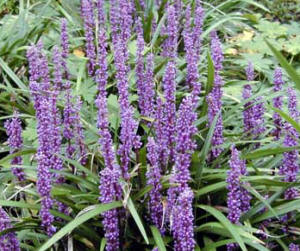
Lilyturf Grass
The first thing to say about Liriope muscari, is that it is not a true grass. However, many writers - and nurseries - put it in the ornamental grass section, so we will do the same. Liriope is related to another non-grass - Ophiopogon Black Dragon and for the sake of clarification, both are related to the Lily of the Valley (Convalaria).
As a 'grass' Liriope is totally out of place, for it has bright blue tiny bell flowers. Nonetheless, it is a very useful low growing plant - evergreen at that - and flowers in late autumn and through to the winter.
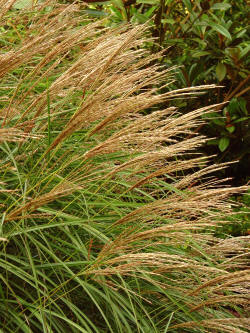
Miscanthus sinensis
The Miscanthus group of grasses are proving to be the most popular grass. They are generally tall, upright growing, but taking little room at ground level, so easy to fit into an existing shrub or perennial border.
Miscanthus sinensis are spectacular grasses through mid summer and on into the winter. Firstly with their flower plumes of white, cream or pink shades, which then turn into seedheads as the grasses settle in for the Autumn and winter months.
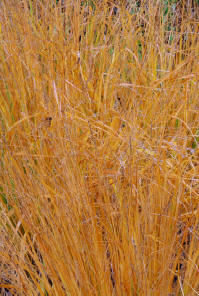
Molinia caerulea
There are two basic species of Molinia that we are interested in on this page as far as ornamental grasses are concerned. They are Molinia caerulea and the subspecies M. c subsp. arundinacea. They share a common name of Purple Moor Grass. The purple aspect probably refers to the 'moors' for the plant has no purple colouring!
There are several varieties within those groups that are good for garden use. Molinia are quite dainty grasses - generally having tidy clumps of foliage with long erect stems of flowers.
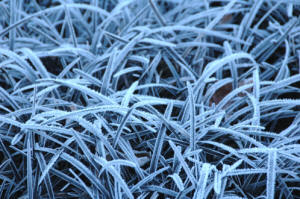
Black Dragon
The Dwarf Black Grass - Ophiopogon planiscapus Nigrescens - is evergreen, spreading and dwarf. It grows to a maximum of 20cm high. Its ultimate spread depends much on its planted environment.
The Black Dragon Ornamental Grass is best planted in contrast to other plants, or can be easily overlooked! It is good if allowed to meander onto - and through - a gravel path. It spread by way of underground rhizomes - but not quickly.
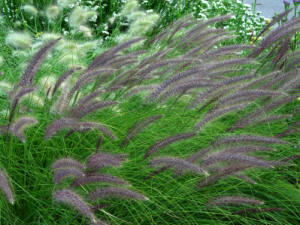
Panicum
The Panicum grasses lend themselves to some bold plantings - and contrast well in shape and colour with many garden plants. They have long periods of flowering, and the seedheads are attractive in Autumn.
Panicum are normally perennial, but some such as Panicum miliaceum are annual. All prefer to be planted in sunny positions - Herbaceous border and shrub bed are two areas of possibility, but so too is planting in Patio Pots!
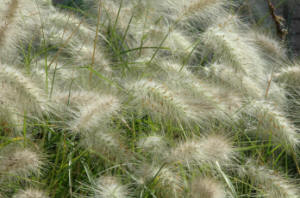
Pennisetum villosum
Pennisetum are typified by the feathery plume flowers, normally nodding from arching stems.
They are all low growing and best suited to the front of a bed or border where the bending flower stems and fluffy flowers can best be seen.

Stipa Arundinacea
The Stipa group of grasses are wide ranging and very useful for many garden aspects. They are a landscape gardener's dream plant. Garden Designers use Stipa grasses for their form, for their colour range, their differing heights and growth habits, and for their long periods of interest. From early summer through to mid winter.
Most of the Stipa range of grasses are perennial - some evergreen - but they all share a liking of an open aspect, and are rarely found in shade in natural habitats.
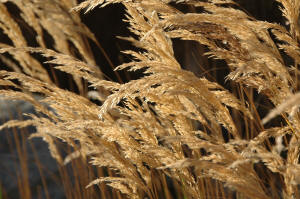
Stipa calamagrostis
If you have seen pheasants in the wild, then you will see how this grass has acquired its common name - Pheasant Tail Grass would be better. The other common name used is Korean Feather Grass, but that is applied to several other grasses as well - one of the problems of 'common' names! It also has an alternative name of Achnatherum just to confuse things.
Stipa calamagrostis forms a dens mound of slightly metallic green foliage throughout summer, with a good display of silvery sheen flowers - light brown tinged mauve.

Stipa Gigantea
Stipa gigantea - The Giant Feather Grass or Golden Oat Grass - is normally an evergreen, but sometimes in severe winters - or some planting situations - merely semi evergreen. Whichever, it is a perennial so will grow back each year - quickly! It prefers a dry soil - but will tolerate damp but not waterlogged.
An open situation with no crowding by other plants is best - full sun even better. Think about the natural light from the low autumn sun when deciding where to plant your Stipa gigantea. The tall seed heads will show up well if planted where the sun can shine from the side, with a dark background
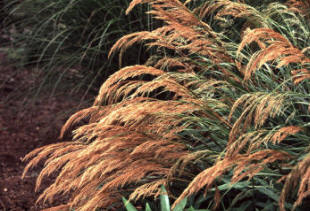
Stipa splendens
This is a grass that is not often planted and is not as popular as many of the other Stipa group. It does not carry the name of Stipa splendens for nothing, for it really is a splendid grass.
The overall height and spread is around 4ft - 1.2m. The flowers are held erect but later arching above the dense foliage mound.
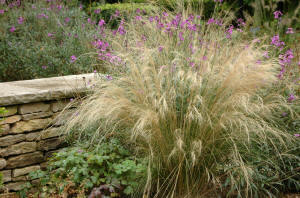
Stipa tenuissima
Stipa tenuissima and Nassella tenuissima are both the same grasses - divided only by the choice of name. Nassella tends to have the common name of Mexican feather Grass. It is a dense tuft of foliage which opens at top, graced my many feathery, pony tail flower spikes. Foliage and flower alike are slender - if massed. As such this grass is absolutely perpetual motion!
An added incentive for you to plant Ornamental Grasses, is that they need hardly any attention or maintenance at all - and that includes watering! Most of the grasses are happy in the dry garden - and in fact many gardens set aside a specific area of dry ground as a dry garden or border specifically for Grasses.
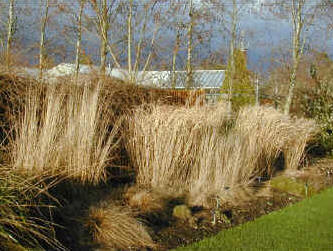
Dead Grasses
Miscanthus, Hordeum, Festuca, Pennisetum, to name a few, are all spectacular from late summer, with their ripened seed heads, and straw coloured foliage. But beyond the late summer and well into the winter, many grass varieties still have value in the garden; as can be seen above.
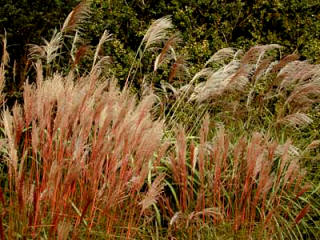
Carex comans
Many of the ornamental grasses are drought resistant. You only need to study their natural habitat and see this. It's strange that in drought conditions, we are normally happy for them to change from their lush green foliage to a straw coloured mass..